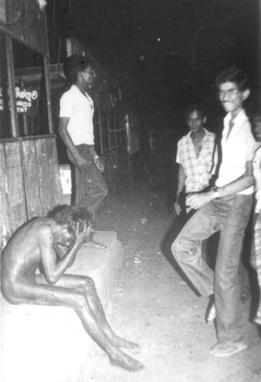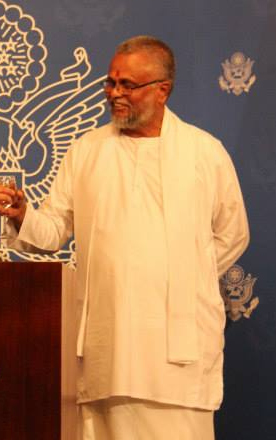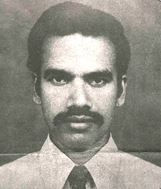
The Special Task Force (STF) (Sinhala: විශේෂ කාර්ය බලකාය Visesha Karya Balakaya; Tamil: சிறப்பு அதிரடிப் படை) is an elite police tactical unit of the Sri Lanka Police specialising in clandestine and covert operations, combat and patrolling in urban areas, combat search and rescue, counterinsurgency and counterterrorism operations, crowd control, executive protection, forward observer, hostage rescue, indirect fire, irregular warfare, jungle and mountain warfare, parachuting, psychological warfare, search and rescue people who are in distress or imminent danger from disaster. serving high-risk arrest and search warrants, special reconnaissance, support military operations, tactical emergency medical, tracking, and unconventional tactics. It was formed in 1983 not as a military force, but rather as a highly specialised armed police unit.

Black July was an anti-Tamil pogrom that occurred in Sri Lanka during July 1983. The pogrom was premeditated, and was finally triggered by a deadly ambush on 23 July 1983, which caused the death of 13 Sri Lanka Army soldiers, by the Tamil militant group Liberation Tigers of Tamil Eelam (LTTE). Although initially orchestrated by members of the ruling UNP, the pogrom soon escalated into mass violence with significant public participation.
The Welikada Prison Massacre took place during the 1983 Black July pogrom against Sri Lankan Tamil minority in Colombo, Sri Lanka. Fifty-three prisoners were killed inside a high-security prison. No one has been convicted of crimes relating to these incidents.
The Kalutara Prison Riots occurred on 12 December 1997, at the high-security prison in Kalutara, Sri Lanka. Three minority Tamil political prisoners were killed by majority Sinhalese prisoners. No one has yet been convicted for these crimes.

Kathiravelu Nythiananda Devananda, commonly known as Douglas Devananda, is a Sri Lankan Tamil politician, Cabinet Minister and leader of the Eelam People's Democratic Party. Originally a Sri Lanka Tamil militant who fought against the Sri Lankan government for an independent Tamil Eelam, he became a pro-government paramilitary leader and politician. Due to his strong opposition to and vocal criticism of the rebel Liberation Tigers of Tamil Eelam, they unsuccessfully tried to assassinate him over 10 times. Devananda is a proclaimed offender in India and is wanted on charges of murder, attempt to murder, rioting, unlawful assembly and kidnapping. He was sworn in as Minister of Fisheries and Aquatic Resources on 22 November 2019.
The Welikada Prison is a maximum-security prison and the largest prison in Sri Lanka. It was built in 1841 by the British colonial government under Governor Campbell. The prison covers an area of 48 acres (190,000 m2). It is overcrowded with about 1700 detainees exceeding the actual number that could be accommodated. The prison also has a gallows and its own hospital. The prison is administered by the Department of Prisons.
Selvarajah Yogachandran, also known as Kuttimani was one of the leaders of the former Tamil militant organization TELO from Sri Lanka. He was arrested and sentenced to death, and was killed in the 1983 Welikada prison massacre along with the other TELO leader Nadarajah Thangathurai.

Nadarajah Thangavelu was a Sri Lankan Tamil rebel and one of the founders of the Tamil Eelam Liberation Organization, a separatist Tamil militant organisation in Sri Lanka.
Ganeshanathan Jeganathan was a political writer and one of the members of former Tamil militant organization Tamil Eelam Liberation Organization (TELO). He was arrested and sentenced to death and was killed in the 1983 Welikada prison massacre during the Black July riots in Sri Lanka, along with the TELO leaders Nadarajah Thangathurai & Selvarajah Yogachandran.

The Apodaca prison riot occurred on 19 February 2012 at a prison in Apodaca, Nuevo León, Mexico. Mexico City officials stated that at least 44 people were killed, with another twelve injured. The Blog del Narco, a blog that documents events and people of the Mexican Drug War anonymously, reported that the actual (unofficial) death toll may be more than 70 people. The fight was between Los Zetas and the Gulf Cartel, two drug cartels that operate in northeastern Mexico. The governor of Nuevo León, Rodrigo Medina, mentioned on 20 February 2012 that 30 inmates escaped from the prison during the riot. Four days later, however, the new figures of the fugitives went down to 29. On 16 March 2012, the Attorney General's Office of Nuevo León confirmed that 37 prisoners had actually escaped on the day of the massacre. One of the fugitives, Óscar Manuel Bernal alias La Araña, is considered by the Mexican authorities to be "extremely dangerous," and is believed to be the leader of Los Zetas in the municipality of Monterrey. Some other fugitives were also leaders in the organization.
Events from the year 2012 in Sri Lanka.
Dr. S Rajasundaram was a Sri Lankan Tamil activist known for his struggle for the rights of Tamil people in Sri Lanka, through peaceful and democratic means. Along with his friend S.A. David, He founded Gandhiyam, a social service organization, named after the Indian revolutionary Mahatma Gandhi, that was aimed at economic, social, cultural revival of the Tamils and also fight the Sri Lankan state's repeated and continued policies of oppressing the Tamils and denying them of their rights. The Sri Lankan government unlawfully arrested along with him, several thousands Tamil activists and he was sentenced to the Welikada Prison where he was subsequently killed during the anti-Tamil pogrom of 1983.
Solomon Arulanandam David was a Sri Lankan Tamil architect, activist and founder of the Gandhiyam Movement.
Sanmugam Appacuddy Tharmalingam was a Sri Lankan Tamil physician, politician and Mayor of Jaffna.
A three-day prison takeover and stand-off took place in 2018 between the Indonesian National Police and inmates convicted of terrorist activities who were imprisoned at the Police's Mobile Brigade Corps's headquarters in Depok, West Java, Indonesia. The inmates took control over one prison block and 6 police officers were taken hostages. As a result of the standoff, five police officers died, with one inmate dead after being shot by the police. Four policemen were also injured in the incident. The Islamic State claimed its fighters were in the standoff. Another policeman was stabbed to death at the headquarters of the elite Mobile Brigade police after the siege by a terrorist who was later shot and killed.

On 21 April 2019, Easter Sunday, three churches in Sri Lanka and three luxury hotels in the commercial capital, Colombo, were targeted in a series of coordinated ISIS-related terrorist suicide bombings. Later that day, two smaller explosions occurred at a housing complex in Dematagoda and a guest house in Dehiwala. A total of 269 people were killed, including at least 45 foreign nationals, three police officers, and eight suicide bombers. An additional 500 were injured. The church bombings were carried out during Easter services in Negombo, Batticaloa and Colombo; the hotels bombed included the Shangri-La, Cinnamon Grand, Kingsbury and Tropical Inn. According to the State Intelligence Service, a second wave of attacks was planned, but was prevented due to government raids.
Mahara prison riot was an arson attack which took place between the prison inmates and police officials from 29 November 2020 to 30 November 2020 at the Mahara Prison in Sri Lanka at the outskirts of the capital city of Colombo in Mahara. As of 30 November 2020, 11 inmates were reportedly killed and about 117 inmates were severely injured during the prison riot. Police guards opened fire to control the arson attack and also in order to prevent a jail break. A fire also spread from the Mahara fire following gun shots, and most of the deceased inmates succumbed to gun shots. It was revealed that prison inmates set fire to the kitchens inside the prison facility and briefly took 2 wardens hostage. The riots occurred following the rumours and speculations regarding the transferring of COVID-19 infected prisoners to Mahara Prison from other crowded prisons. Initially the prison inmates staged unrest demanding the officials and authorities to increase the PCR testing following the surge in COVID-19 cases in Sri Lankan prisons. Prior to the riots, around 12 prisoners tested positive for COVID-19.
Angunakolapelessa Prison, is a maximum security prison in the Hambantota District of Sri Lanka. The prison complex occupies a site of 26 ha and the total number of inmates that can be accommodated at the prison is 1,200






